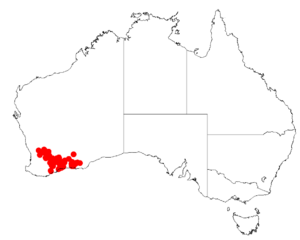Acacia brachyclada facts for kids
Quick facts for kids Acacia brachyclada |
|
|---|---|
| Scientific classification | |
| Genus: |
Acacia
|
| Species: |
brachyclada
|
 |
|
| Acacia brachyclada occurrence data from Australasian Virtual Herbarium | |
Acacia brachyclada is a type of shrub that belongs to the large group of plants called Acacia, also known as wattles. It's a special kind of wattle found in Australia.
About This Shrub
This shrub is usually dense and rounded, but it can also spread out. It feels a bit sticky because it has resin. It typically grows to be about 0.3 to 1.2 meters (about 1 to 4 feet) tall.
Its leaves, which are actually flattened leaf stalks called phyllodes, are green and shaped like an oval or a long ellipse. They are small, usually 2 to 7 millimeters (about 0.08 to 0.28 inches) long and 2 to 4 millimeters (about 0.08 to 0.16 inches) wide.
Acacia brachyclada blooms, or flowers, from August to January. It produces bright yellow flowers. These flowers grow in simple, round clusters, with each cluster usually having 12 to 16 golden flowers. Later, smooth seed pods form. These pods are tightly and unevenly coiled, measuring 2.5 to 4.5 millimeters (about 0.1 to 0.18 inches) wide. Inside the pods are oblong-shaped seeds, about 3 to 4 millimeters (about 0.12 to 0.16 inches) long.
How It Was Named
This plant was first officially described by a botanist named William Vincent Fitzgerald in 1912. He wrote about it in a publication called New West Australian Plants. Journal of Botany, British and Foreign.
For a short time, in 2003, another botanist named Leslie Pedley reclassified it. He gave it a different scientific name, Racosperma brachycladum. However, in 2006, it was moved back to its original group, the Acacia genus.
Where It Grows
Acacia brachyclada is native to certain areas in Western Australia. You can find it in regions like the Wheatbelt, Great Southern, and Goldfields-Esperance.
It mostly grows on gently rolling plains and in low-lying areas. It can grow in different types of soil, including clay, loam, sandy, or chalky soils. This shrub is often found alongside mallee scrub or in woodland areas.

